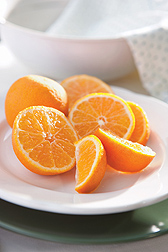This page has been archived and is being provided for reference purposes only. The page is no longer being updated, and therefore, links on the page may be invalid.
| Read the magazine story to find out more. |
|
|
Protecting the Flavor of Mandarin Oranges
By Marcia Wood
October 8, 2014
Sweet, juicy mandarin oranges get their pleasing flavor from a complex blend of natural chemicals. In ongoing experiments, U.S. Department of Agriculture (USDA) scientist David M. Obenland and co-investigator Mary Lu Arpaia, with the University of California Riverside, are taking a close look at how storage temperatures and the amount of time in storage at packinghouses affect the flavor of these small, colorful oranges.
Their research is among the most extensive of its kind for this specialty fruit. To date, their tests have involved working with the peeled fruit or juice of more than 19,000 fresh mandarin oranges that were harvested from at least a half dozen research and commercial orchards in California. That state produces the bulk of the nation's harvest of tangerines, clementines, and other kinds of mandarins.
Most of that fruit probably spends at least some time in cold storage, followed by a period of warmer storage, according to Obenland, who is with Agricultural Research Service’s (ARS) San Joaquin Valley Agricultural Sciences Center in Parlier, California. ARS is USDA’s chief intramural scientific research agency.
His research with Arpaia addresses each phase separately, an approach that apparently has made the studies unique among most other published mandarin flavor investigations.
One of their experiments has shown that cold storage temperatures influence the flavor of the classic W. Murcott Afourer oranges, often referred to simply as W. Murcott mandarins, but not the flavor of the Owari variety.
In other work, the researchers found that significant changes in several flavor-associated chemicals occurred soon after W. Murcott mandarins were brought out of cold storage. In brief, significant increases in three chemicals (ethyl acetate, ethyl propanoate and ethyl 2-methylpropanoate) that belong to a class known as ethyl esters occurred within the first 24 hours after the mandarins were moved from 41-degree Fahrenheit storage into 68-degree Fahrenheit storage. Significant increases in a fourth ethyl ester, ethyl 2-methylbutanoate, took place a day later.
All four ethyl esters are thought to contribute to a sweet, fruity aroma, which may have a role in what is perceived as flavor. However, it has been suggested that high levels of these four compounds may contribute to off-flavor. The team's ongoing studies might help pinpoint optimal levels of the four chemicals.
Read more about this research in the October 2014 issue of Agricultural Research magazine.
Obenland, Arpaia, ARS statistician Bruce Mackey at Albany, California, and Arpaia’s University of California colleagues Sue Collin and James Sievert published these findings in the journal Postharvest Biology and Technology in 2011 and 2013.
Financial support for the research has come from the California Citrus Research Board, a grant from the U.S. Israel Binational Research and Development Fund, and ARS.

